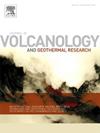肯尼亚裂谷南部Olkaria火山复合体和Longonot火山爆炸性硅质过碱性喷发的时空演化
IF 2.4
3区 地球科学
Q2 GEOSCIENCES, MULTIDISCIPLINARY
Journal of Volcanology and Geothermal Research
Pub Date : 2025-01-20
DOI:10.1016/j.jvolgeores.2025.108275
引用次数: 0
摘要
肯尼亚南部裂谷的Olkaria火山复合体和邻近的Longonot火山拥有重要的地热资源,但由于其长期的爆炸性喷发历史,也构成了火山危险。奥尔卡里亚是一个多中心的穹窿复合体,由熔岩穹窿、陨石坑和裂缝组成,这些裂缝是由过碱性流纹岩喷发后形成的。朗格诺特火山是一个流速性火山口,位于奥尔卡利亚以东10公里处,有一个中央山顶火山口,主要特征是浮石和火山灰喷发。本研究通过对广泛分布的火山碎屑沉积进行详细的野外、地球化学和年代学调查,重建了它们的演化过程。浮石、火山灰沉降物和火山碎屑密度流沉积的测井序列可以建立一个跨越过去42 ka的区域地层格架。10个关键的喷发单元记录了奥尔卡里亚和朗格诺特的爆炸阶段,8个40Ar/39Ar年龄,放射性碳测年首次提供了两座火山的准确年龄限制。在我们的野外地区发现的最古老的爆炸性矿床与Maiella浮石(MP)的大震级喷发(338-333 ka)有关,代表了肯尼亚南部裂谷的第一次爆炸性硅质过碱性喷发。在奥卡利亚,我们的地层格架中保存最早的矿床是42-37 ka的火山碎屑密度流(OP)和浮石沉降(OFB),代表了早期流纹岩穹丘喷发。叠合沉积表明,在37ka至17ka (LAP)期间,朗格诺特同时经历了重复的大爆炸喷发,取代了浮石落下沉积。17ka后,LAP火山爆发被单一的玄武岩粗面山岩、粗面山岩和粗面浮石(LMx)混合喷发打断,随后是Longonot (LA1)持续的粗面火山灰喷发。与此同时,Olkaria在17ka至14ka过渡到局部熔岩穹丘的建造和崩塌,产生了块状和火山灰流(OD1-2)。较年轻的朗格诺特火山灰喷发(LA2)和最近在奥尔卡里亚的Ololbutot中心(OD3)发生的191±23 calyr BP的喷发活动表明,这两座火山在整个全新世都保持活跃。在这两个系统中,广泛分布的跌落单元的最小估计震级在4到5级之间(DRE沉积物体积为0.04-0.35 km3),代表了实质性的区域危害,喷发频率平均为隆格诺特每~ 2000年一次中等-大型喷发(4 - 5级),奥尔卡利亚每~ 200年一次小型-中等爆炸性喷发(3级),直到大约10 ka,之后的喷发明显较小且更局部。浮石玻璃地球化学的统计分析使Olkaria矿床的指纹识别可能的来源喷口,跟踪整个复杂的时空变化。奥尔卡里亚火山和朗格诺特火山较大的爆炸性喷发分散了大量火山碎屑物质(浮石和/或火山灰),在距离朗格诺特火山源喷口约20公里处产生了厚达1米的沉积物,这表明未来类似规模的喷发可能会影响多达20万人,强调有必要将喷发历史重建与危害分析结合起来,以推进防范和减灾战略。本文章由计算机程序翻译,如有差异,请以英文原文为准。
Temporal and spatial evolution of explosive silicic peralkaline eruptions at the Olkaria Volcanic Complex and Longonot volcano in the Southern Kenya Rift
The Olkaria Volcanic Complex and adjacent Longonot volcano in the Southern Kenya Rift host major geothermal resources yet also pose volcanic hazards owing to their long histories of explosive eruptions. Olkaria is a multicentred dome complex consisting of lava domes, craters and fissures produced following the eruption of peralkaline comenditic rhyolites. Longonot is a trachytic caldera hosting a central summit crater, situated <10 km east of Olkaria, with pumice and ash eruptions being a dominant feature. This study reconstructs their evolution through detailed field, geochemical and geochronological investigations of widespread pyroclastic deposits. Logging sequences of pumice and ash fallout and pyroclastic density current deposits enables establishing a regional stratigraphic framework spanning the past 42 ka. Ten key eruptive units record explosive phases at Olkaria and Longonot, with eight 40Ar/39Ar ages and a radiocarbon date providing the first accurate age constraints of both volcanoes. The oldest explosive deposits identified in our field area are associated with the large-magnitude Maiella Pumice (MP) eruptions (338–333 ka), representing one of the first explosive silicic peralkaline eruptions in the Southern Kenya Rift. Within Olkaria, the earliest preserved deposits in our tephrostratigraphic framework are 42–37 ka pyroclastic density currents (OP) and pumice fallouts (OFB) representing early rhyolitic dome eruptions. Overlapping deposits reveal Longonot concurrently experienced repetitive large explosive eruptions emplacing pumice fall deposits from 37 ka to 17 ka (LAP). After 17 ka, LAP eruptions were punctuated by a single eruption of mixed basaltic trachyandesite, trachyandesite and trachyte pumice (LMx), followed by persistent trachyte ash venting at Longonot (LA1). Simultaneously, Olkaria transitioned to localised lava dome construction and collapse generating block-and-ash flows from 17 ka to 14 ka (OD1–2). Younger Longonot ash eruptions (LA2) and recent 191 ± 23 cal yr BP effusive–explosive activity at Olkaria's Ololbutot centre (OD3) reveals both volcanoes have remained active throughout the Holocene. Minimum estimated magnitudes for widespread fall units at both systems range between 4 and 5 (DRE deposit volumes of 0.04–0.35 km3), representing substantial regional hazards, with eruption frequencies averaging up to one moderate–large eruption (magnitude 4–5) every ∼2000 years for Longonot and one small–moderate explosive eruption (magnitude ∼3) every ∼200 years for Olkaria until ca. 10 ka, after which eruptions are significantly smaller and more localised. Statistical analysis of pumice glass geochemistry enables the fingerprinting of Olkaria deposits to likely source vents, tracking spatial-temporal variability across the complex. The larger explosive eruptions at both Olkaria and Longonot dispersed voluminous pyroclastic material (pumice and/or ash), which generated up to 1-m-thick deposits located ∼20 km from its source vent in the case of Longonot, suggesting up to 200,000 people could be impacted from future similar magnitude eruptions, emphasising the necessity to combine eruptive history reconstructions with hazard analysis to advance preparedness and mitigation strategies.
求助全文
通过发布文献求助,成功后即可免费获取论文全文。
去求助
来源期刊
CiteScore
5.90
自引率
13.80%
发文量
183
审稿时长
19.7 weeks
期刊介绍:
An international research journal with focus on volcanic and geothermal processes and their impact on the environment and society.
Submission of papers covering the following aspects of volcanology and geothermal research are encouraged:
(1) Geological aspects of volcanic systems: volcano stratigraphy, structure and tectonic influence; eruptive history; evolution of volcanic landforms; eruption style and progress; dispersal patterns of lava and ash; analysis of real-time eruption observations.
(2) Geochemical and petrological aspects of volcanic rocks: magma genesis and evolution; crystallization; volatile compositions, solubility, and degassing; volcanic petrography and textural analysis.
(3) Hydrology, geochemistry and measurement of volcanic and hydrothermal fluids: volcanic gas emissions; fumaroles and springs; crater lakes; hydrothermal mineralization.
(4) Geophysical aspects of volcanic systems: physical properties of volcanic rocks and magmas; heat flow studies; volcano seismology, geodesy and remote sensing.
(5) Computational modeling and experimental simulation of magmatic and hydrothermal processes: eruption dynamics; magma transport and storage; plume dynamics and ash dispersal; lava flow dynamics; hydrothermal fluid flow; thermodynamics of aqueous fluids and melts.
(6) Volcano hazard and risk research: hazard zonation methodology, development of forecasting tools; assessment techniques for vulnerability and impact.

 求助内容:
求助内容: 应助结果提醒方式:
应助结果提醒方式:


